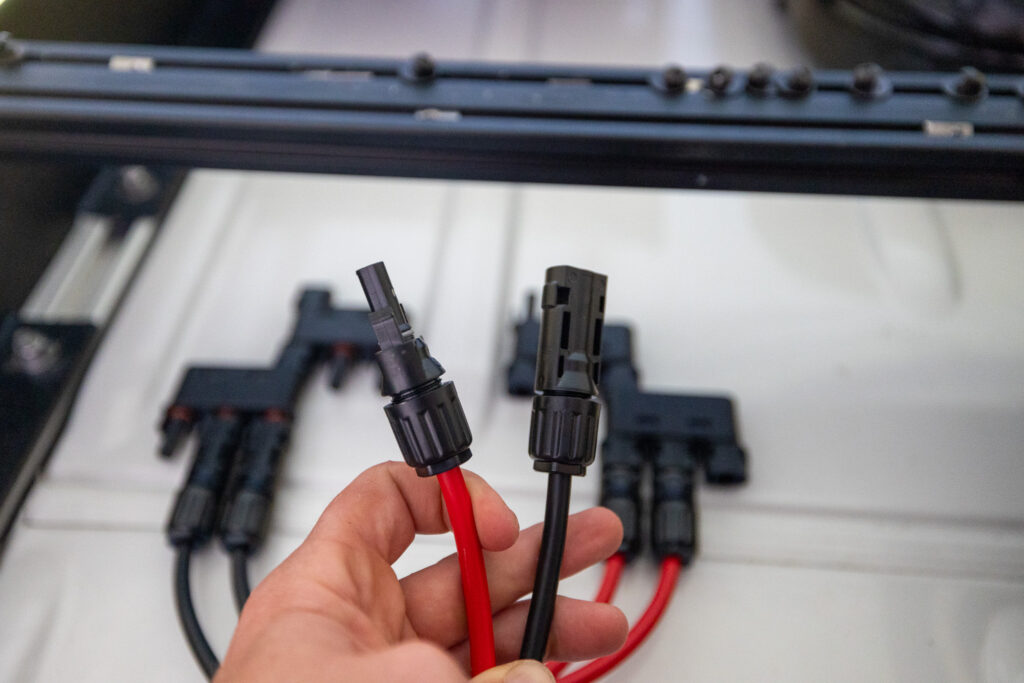We’ve installed two solar arrays from scratch. The first time, we installed 700W of flexible solar, on our boat where we cruised full time for two years. The second time we, installed 825W of Walkable Solar on our sprinter van for full-time van life. We also wrote an electrical e-book for our boating audience, so hopefully, we can share the essential tips here for your RV, and Camper Van Solar needs! Leave a comment below if you have a specific question, and we’ll get back to you!
Note: We use affiliate links which provide us a little kickback each time you use one of our links and make a purchase, without any additional cost to you. We do not recommend products that we don’t already love or have heard great things about, so you can trust we’re only suggesting great products to you.
The Basic Components of a Solar Power System
Solar Power is as accessible as it ever has been. With about 30 minutes and couple hundred dollars, you can have a complete solar system delivered to your house within the day, and installed in the next day.
Of course, the research and understanding are the hardest and most time-consuming parts. Hopefully, this article demystifies solar and gives you some actionable tasks for installing solar on your RV or Camper Van.
The critical parts of any solar system, are solar panels, a charge controller, and a battery bank.

The Panels
Solar panels are the first thing people think of when they think of solar power. Typically, the larger the panel, the more power, but it’s also based on the type of panel. The more rigid a panel, the more efficient it will be! We’ll explain the types of panels below.
| Category | Energy |
|---|---|
| Rigidity | ⬆️ |
| Size | ⬆️ |
The Charge Controller
Since Solar panels have different levels of power coming depending on the angle of the sun, and your batteries need a specific voltage, you need a component called a charge controller to convert the energy into safe and usable levels.

Choosing a charge controller is easy, just make sure it is rated for more than your panel’s Voltage and Current combination and then wire it up with 4 terminals. For example, the charge controller above is a 100 | 50 MPPT charge controller. This means that the maximum Voltage is 100V and the maximum amperage at one time is 50A. Since our panels are 26V and 6A panels, we need to make sure the are under 100V and 50A after all is wired up. Charge controllers are super simple to wire up, just making sure you have a large enough controller is important!
⏰ Make sure your charge controller is “future proof” by buying a slightly larger one than you need now, in case you decide to add a panel in the future!
The Battery Bank
While solar is for charging or topping up your battery power, your battery bank is equally as important for saving that charge through the cloudy and rainy days. Depending on your need (read below to determine that), you may need to spend less on solar and more on your battery bank!

The Types of Solar Panels for RVs
There are three types of solar panels used in RVs and Camper vans. Each has its tradeoffs, so read below to determine the best one for you!
🚀 Efficiency of a panel is how much solar you get for the size of the panel. When you search for different panels, look at their dimensions. Not all panels are created equally!
Rigid Panels
Rigid panels, also known as monocrystalline panels, are the most popular solar panel option for RVs and camper vans. These hard, fixed panels are the most efficient and the least expensive. They need to be mounted on a flat surface and mounted to your roof.
💡 Most solar panel arrays will use rigid panels.
Flexible Panels
Flexible panels are a little bit less efficient than rigid panels, and for that, you gain “flexibility” when mounting 🫣. These panels are perfect for attaching to fabric or matching the slight curve of a roof. These are slightly more expensive than rigid panels; however, some installation scenarios will require flexible solar panels. We had four flexible panels installed to our bimini on our boat. Since the bimini was fabric and would slightly move with the wind, flexible panels were the right choice!


Walkable Panels
Finally, the last type of solar panels for RVs that are becoming more and more popular is walkable solar panels. These panels are semi-rigid (read: less flexible than flexible and more flexible than rigid) and they have a durable top allowing them to be walked on. These panels are efficient but very expensive, and that is the trade-off here.

We purchased five walkable panels for the roof of our sprinter van, and at almost four-times the cost of a rigid array, we gained a usable roof deck, with maximum solar. The addition of this outdoor deck for future travels will hopefully be worth the additional cost. Time will tell!

Check out our blog post on Everything You Need to Know about Roof Racks.
Portable Solar Panels
While not a specific type of panel, portable solar panels are yet another type of solar you’re capable of getting for your RV or camper van. Portable panels are solar arrays that you can easily set up and tear down. They can be large or small enough to bring hiking. These require limited to no mounting or installation and are great if you are using a portable battery system like EcoFlow. We don’t recommend them for the majority of use cases unless you have a portable battery system. This is because you can only take them out at camp, which gives for most people is a short time of actually being on the road. For example, you wouldn’t set them up at a Walmart parking lot or any short over night (because its night 😅), compared to mounted solar which is always working for you!
The Best Way to Connect your Solar Panels
How you connect your solar panels is probably the most important part of designing and implementing your solar power for your camper van or RV. You need to ensure your wires and connections are rated for your solar panel load. We suggest getting your wire plan checked by a qualified electrician. The decisions you make with wiring impact what size of wires you need as well as what charge controller you’ll need to buy.

What size of wire do you need for your solar panels
In general, you’ll want to use the standard wire size for mobile solar arrays, 10 AWG. These will most likely be the size of wires that are included with your panels, so if your entire array uses 10AWG, it makes the connections the most simple, and we like simple!

⚡️ We use the blue sea systems wire calculator for checking safe wire sizes.
What to use to connect solar panel wires together
MC4 connectors are the standard waterproof connectors for connecting your solar panels. Most panels come with MC4 connectors already included, and you can by different connectors allowing your to plug multiple solar panels together.

Series
Connecting your panels in series is similar to how Christmas Tree lights used to work. If one light is out, the rest of the chain suffers, and the series installation method for solar panels is the same. If one panel is shaded, you get reduced output from the rest of the chain. However, panels in series require smaller wires, allowing you to keep that 10AWG wire for your system.
Parallel
Connecting your wires in parallel reduces the challenges with shading but comes with the tradeoff that it provides much more current, which will require larger wires. You can think of a parallel circuit installation method as the lights in your house. One switch can be on, and it won’t affect the next switch in your house.
The optimal way to wire
Our strategy is to take the number of panels you have, and group them in packs of two. Connect the two in series and the packs in parallel. This gives you the best of both worlds! Since we have five panels on our sprinter van, we unfortunately, couldn’t easily group the panels. So we put all five in parallel and upgraded our wires to 8 AWG. This added quite a bit of complexity and cost, but will give us the maximum possible solar!
Again, ensure you check with a professional before you finish wiring your panels. With electricity comes the danger of sparks and fires, so it’s best to be extra cautious here.
How Much Solar Do You Need for Your Camper
Solar, much like your battery bank, is a numbers game, and the more, the merrier! Typically, you’ll be limited by budget and size of your roof, though. We recommend looking at your goals and going from there. Do you want something to keep your batteries topped while it stays in your driveway? You may need only one 100W-150W panel in this case. However, if you want solar to be a prime component of full-time van life, you’ll want to cover your roof (as much as possible) with solar panels. It’s a game of feast and famine; some days, you’ll have great solar with no clouds and direct sunlight, and other days, it’ll be cloudy and rainy, and you’ll be lucky to get a trickle. This is the primary reason why we splurged for walkable solar; we can cover our rooftop with as much solar as possible and have a rooftop deck.

How to Mount Solar to Your Van
If you think about it, when you drive down the highway at 70 mph, that’s almost a category 1 hurricane. If you have a 20 or 30-mph headwind, then 😮💨 You’ll want to make sure you have your solar panels mounted securely!
How you mount solar panels to your van is mostly dependent on the type of panel and the connections you have available. Most panels have 4 mounting points for each corner, and if you have rigid panels, this will most likely be enough.

For flexible or walkable panels, you need a bit more thought into your mounting. This is because the flexible solar panel can get caught by the wind and then all of a sudden you have a sail. This can rip the solar panel off of your roof, so you need additional mounts for the edges.
To do this, we used aluminum J-Channels and H-Channels and secured them to our roof rack via 3M VHB tape.
How to Get Your Solar Panel Wires Into Your Vehicle
For the final section on roof top solar for your camper van or RV, we need to determine the best way to get these into your vehicle. By far the most popular way is via a solar roof entry gland. These are curved for optimal wind flow, easy to attach just with sealant (we recommend Sikaflex 221 for bonding), and come with two cable entries – perfect for positive and negative!


The other option is using a junction box for more wires. It is not as aerodynamic as the other cable entry gland, but this option was available for us as it’s underneath our roof rack! We have six wires incoming, two for solar, two for our rear scene lights, and two for our starlink, and we didn’t want three separate holes into our van, so we installed a waterproof junction box from Lowe’s. This junction box comes with two connectors, and we drilled out four more and added 1/2” waterproof NPT connectors. Then we used the existing hole with a PVC pipe to route the cables in! We sealed with Sikaflex 221 and the job was done.
Watch our Solar Install on YouTube
Save for Later
Save this to Pinterest to read again later!












Leave a Reply